国际贸易经典案例三:Levi Strauss
服装品牌故事
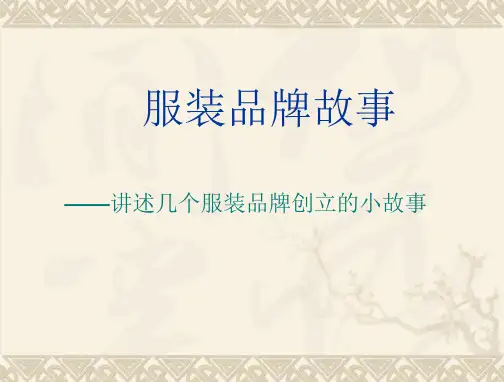
利维·斯特劳斯公司的牛仔裤在1996年达到销售高 峰,全年销售总值达71亿美元。
3. 霍伯特.德.纪梵希
1927年,纪梵希出生在法国的一个富有家庭,父亲 是矿山业主,家里并不赞同年轻的纪梵希从事时装 事业,而是希望他能成为一名律师,但纪梵希坚定 了自己的选择。
1945年,毕业于巴黎艺术学校后,1952年,创建 “纪梵希工作室”(the House of Givenchy)。
在西方国家,演艺界的名人是范思哲注目的对象,一旦这些名人穿上范 思哲的服装参加奥斯卡的颁奖仪式,电视台把各位大明星的形象向全世 界一转播,范思哲的作品自然而然就传向了全世界。
1998年,泽塔琼斯穿着一身紧裹身体的红 色范思哲长裙出现在奥斯卡颁奖礼上,立 时谋杀了记者们手中的无数菲林,成为了 当晚的最佳着装人士。
成年之后的夏奈尔孤身来到巴黎,她的 选择非常有限:枯燥乏味的针线手工, 连一句台词都没有的舞台小摆设人 物……这一切,夏奈尔都做过。
这样,直到夏奈尔自己在多薇开了一家 店,小小的帽子店。
此时,时髦女人所戴的帽子多为花里胡 哨、结构复杂。可可以敏锐的时尚触觉, 推出田园风格的小草帽,用金黄色麦草 编织,周围还种着叶片儿,养着花朵儿, 似乎还飘散着巴黎少有的泥土芳香。
Gianni Versace 1946 年 12 月 2 日出生 于意大利的雷焦卡拉布里亚。母亲是个 “土”裁缝,曾经开过一个名为“巴黎时 装店”的店铺。她是一个聪明的女人,可 以不用任何纸样,只须在布一标一些记号 便可裁剪成衣。
李维斯
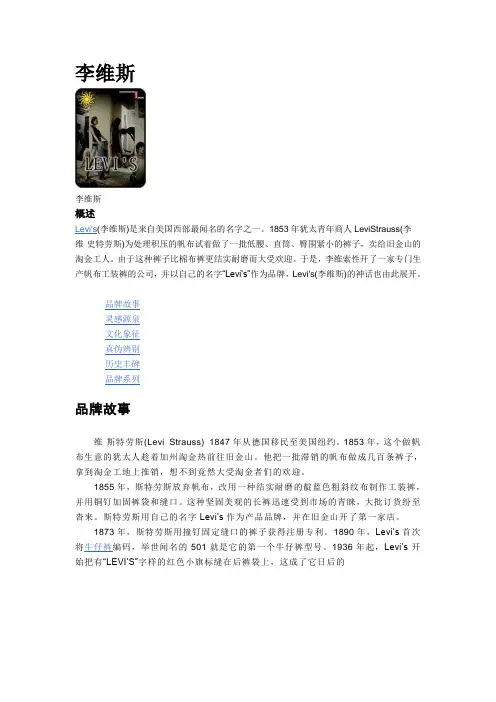
李维斯李维斯概述Levi's(李维斯)是来自美国西部最闻名的名字之一。
1853年犹太青年商人LeviStrauss(李维·史特劳斯)为处理积压的帆布试着做了一批低腰、直筒、臀围紧小的裤子,卖给旧金山的淘金工人。
由于这种裤子比棉布裤更结实耐磨而大受欢迎。
于是,李维索性开了一家专门生产帆布工装裤的公司,并以自己的名字“Levi's”作为品牌,Levi's(李维斯)的神话也由此展开。
品牌故事灵感源泉文化象征真伪辨别历史丰碑品牌系列品牌故事维·斯特劳斯(Levi Strauss) 1847年从德国移民至美国纽约。
1853年,这个做帆布生意的犹太人趁着加州淘金热前往旧金山。
他把一批滞销的帆布做成几百条裤子,拿到淘金工地上推销,想不到竟然大受淘金者们的欢迎。
1855年,斯特劳斯放弃帆布,改用一种结实耐磨的靛蓝色粗斜纹布制作工装裤,并用铜钉加固裤袋和缝口。
这种坚固美观的长裤迅速受到市场的青睐,大批订货纷至沓来。
斯特劳斯用自己的名字Levi’s作为产品品牌,并在旧金山开了第一家店。
1873年,斯特劳斯用撞钉固定缝口的裤子获得注册专利。
1890年,Levi’s首次将牛仔裤编码,举世闻名的501就是它的第一个牛仔裤型号。
1936年起,Levi’s开始把有“LEVI’S”字样的红色小旗标缝在后裤袋上,这成了它日后的levis品牌标记。
1954年,Levi’s牛仔裤皮标停产,开始使用纸标。
1974年,公司开始生产水洗系列牛仔裤,1986年又推出预先磨破穿洞的牛仔裤。
501裤型是Levi’s牛仔裤中最经典的,也是历史最悠久和最畅销的牛仔裤产品,是收藏者的首选。
据说,一条1886年到1902年之间制作的501牛仔裤,在1997年曾经卖到2.5万美元天价。
501设计简单,直筒中腰剪裁,钮扣式设计,臀围位置不完全帖身,穿在身上宽松舒适。
蔡依林热力兄弟李维斯2010新款Levi’s牛仔裤制作相当精良,它的钮扣绝对不会生锈,针脚十分密实。
出口跨境电商知识产权侵权TRO 禁令典型案例分析
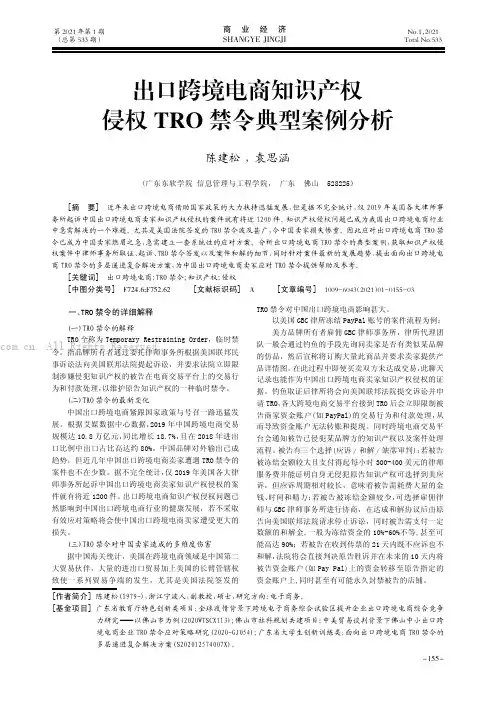
出口跨境电商知识产权侵权TRO 禁令典型案例分析陈建松,袁思涵(广东东软学院信息管理与工程学院,广东佛山528225)[摘要]近年来出口跨境电商借助国家政策的大力扶持迅猛发展,但是据不完全统计,仅2019年美国各大律师事务所起诉中国出口跨境电商卖家知识产权侵权的案件就有将近1200件。
知识产权侵权问题已成为我国出口跨境电商行业中急需解决的一个难题。
尤其是美国法院签发的TRO 禁令波及甚广,令中国卖家损失惨重。
因此应对出口跨境电商TRO 禁令已成为中国卖家燃眉之急,急需建立一套系统性的应对方案。
分析出口跨境电商TRO 禁令的典型案例,获取知识产权侵权案件中律师事务所取证、起诉、TRO 禁令签发以及案件和解的细节,同时针对案件最新的发展趋势,提出面向出口跨境电商TRO 禁令的多层递进复合解决方案,为中国出口跨境电商卖家应对TRO 禁令提供帮助及参考。
[关键词]出口跨境电商;TRO 禁令;知识产权;侵权[中图分类号]F724.6;F752.62[文献标识码]A[文章编号]1009-6043(2021)01-0155-03第2021年第1期(总第533期)商业经济SHANGYE JINGJINo.1,2021Total No.533[作者简介]陈建松(1979-),浙江宁波人,副教授,硕士,研究方向:电子商务。
[基金项目]广东省教育厅特色创新类项目:全球疫情背景下跨境电子商务综合试验区提升企业出口跨境电商综合竞争力研究———以佛山市为例(2020WTSCX113);佛山市社科规划共建项目:中美贸易谈判背景下佛山中小出口跨境电商企业TRO 禁令应对策略研究(2020-GJ054);广东省大学生创新训练类:面向出口跨境电商TRO 禁令的多层递进复合解决方案(S202012574007X)。
一、TRO 禁令的详细解释(一)TRO 禁令的解释TRO 全称为Temporary Restraining Order,临时禁令。
Levi’s广告案例评析

LEVI’S广告 案例评析
1.品牌背景及发展史 2.品牌策略分析 3.品牌主题选择 4.广告作品的表达手法 5.媒介策略
6.社会效应
评析路径
实用文档
实用文档
品牌背景及发展史
(李维斯)是来自美国西部最闻名的名字之一。 1853年犹太青年商人LeviStrauss(李维·史 特劳斯)为处理积压的帆布试着做了一批低腰、 直筒、臀围紧小的裤子,卖给旧金山的淘金 工人。由于这种裤子比棉布裤更结实耐磨而 大受欢迎。于是,李维斯索性开了一家专门 生产帆布工装裤的公司,并以自己的名字 “Levi’s”作为品牌,Levi's(李维斯)神 话也由此展开。
特征明显,运用统一的板式,还有广泛与大 自然结合的摄影作品的运用。
实用文档
Hale Waihona Puke 实用文档媒介策略网络 电视 杂志
实用文档
实用文档
实用文档
社会效应
平面广告和大自然结合,更容易引起人们的注意。而 且广告很有创意,很好的诠释了李维斯的品牌特征。 另外,李维斯在社会上得到了很好的传播,在一定 程度上很好的指导了消费,这也就达到了广告的目 的。
1930年Levi's牛仔裤首次渡过密西西比河以 东。
1960年Levi's快速的扩展。年轻人都变成一 股新兴主力,Levi's也一跃成为年轻的象征。
1987年,李维斯推出日后大红的Dockers产品 线。
1989年,李维斯在美国的销售从原来风光的 5.02亿跌到3.87亿。李维斯的领导地位慢慢 消失。
实用文档
1996年罗伯特·海斯(Robert Haas)领导李维 斯,公司也开始逐步重新定位自己的使命: 李维斯要从一个有责任心的成功企业变为 “休闲服装的权威”。
牛仔大王李维斯的成功史
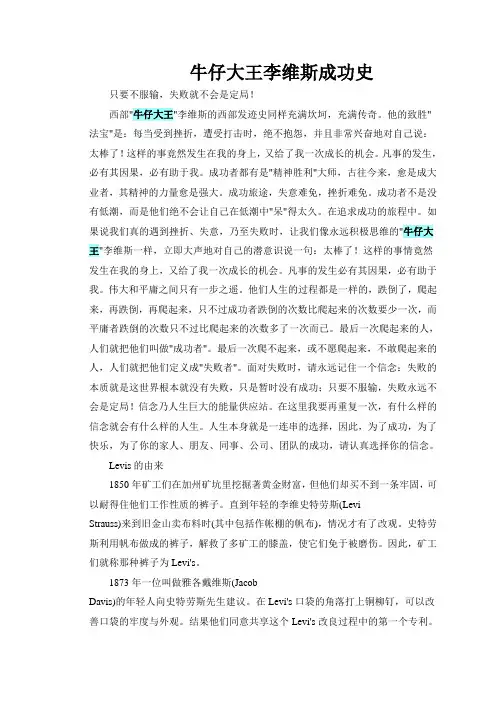
牛仔大王李维斯成功史只要不服输,失败就不会是定局!西部"牛仔大王"李维斯的西部发迹史同样充满坎坷,充满传奇。
他的致胜"法宝"是:每当受到挫折,遭受打击时,绝不抱怨,并且非常兴奋地对自己说:太棒了!这样的事竟然发生在我的身上,又给了我一次成长的机会。
凡事的发生,必有其因果,必有助于我。
成功者都有是"精神胜利"大师,古往今来,愈是成大业者,其精神的力量愈是强大。
成功旅途,失意难免,挫折难免。
成功者不是没有低潮,而是他们绝不会让自己在低潮中"呆"得太久。
在追求成功的旅程中。
如果说我们真的遇到挫折、失意,乃至失败时,让我们像永远积极思维的"牛仔大王"李维斯一样,立即大声地对自己的潜意识说一句:太棒了!这样的事情竟然发生在我的身上,又给了我一次成长的机会。
凡事的发生必有其因果,必有助于我。
伟大和平庸之间只有一步之遥。
他们人生的过程都是一样的,跌倒了,爬起来,再跌倒,再爬起来,只不过成功者跌倒的次数比爬起来的次数要少一次,而平庸者跌倒的次数只不过比爬起来的次数多了一次而已。
最后一次爬起来的人,人们就把他们叫做"成功者"。
最后一次爬不起来,或不愿爬起来,不敢爬起来的人,人们就把他们定义成"失败者"。
面对失败时,请永远记住一个信念:失败的本质就是这世界根本就没有失败,只是暂时没有成功;只要不服输,失败永远不会是定局!信念乃人生巨大的能量供应站。
在这里我要再重复一次,有什么样的信念就会有什么样的人生。
人生本身就是一连串的选择,因此,为了成功,为了快乐,为了你的家人、朋友、同事、公司、团队的成功,请认真选择你的信念。
Levis的由来1850年矿工们在加州矿坑里挖掘著黄金财富,但他们却买不到一条牢固,可以耐得住他们工作性质的裤子。
直到年轻的李维史特劳斯(LeviStrauss)来到旧金山卖布料时(其中包括作帐棚的帆布),情况才有了改观。
2013 国贸 国际商法案例
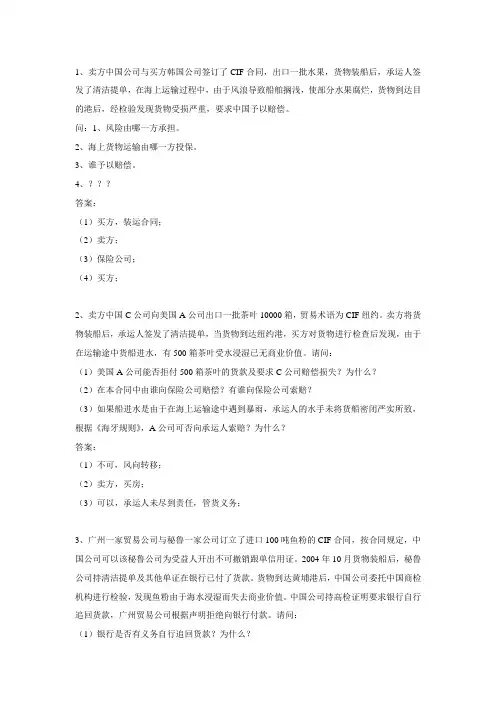
1、卖方中国公司与买方韩国公司签订了CIF合同,出口一批水果,货物装船后,承运人签发了清洁提单,在海上运输过程中,由于风浪导致船舶搁浅,使部分水果腐烂,货物到达目的港后,经检验发现货物受损严重,要求中国予以赔偿。
问:1、风险由哪一方承担。
2、海上货物运输由哪一方投保。
3、谁予以赔偿。
4、???答案:(1)买方,装运合同;(2)卖方;(3)保险公司;(4)买方;2、卖方中国C公司向美国A公司出口一批茶叶10000箱,贸易术语为CIF纽约。
卖方将货物装船后,承运人签发了清洁提单,当货物到达纽约港,买方对货物进行检查后发现,由于在运输途中货船进水,有500箱茶叶受水浸湿已无商业价值。
请问:(1)美国A公司能否拒付500箱茶叶的货款及要求C公司赔偿损失?为什么?(2)在本合同中由谁向保险公司赔偿?有谁向保险公司索赔?(3)如果船进水是由于在海上运输途中遇到暴雨,承运人的水手未将货船密闭严实所致,根据《海牙规则》,A公司可否向承运人索赔?为什么?答案:(1)不可,风向转移;(2)卖方,买房;(3)可以,承运人未尽到责任,管货义务;3、广州一家贸易公司与秘鲁一家公司订立了进口100吨鱼粉的CIF合同,按合同规定,中国公司可以该秘鲁公司为受益人开出不可撤销跟单信用证。
2004年10月货物装船后,秘鲁公司持清洁提单及其他单证在银行已付了货款。
货物到达黄埔港后,中国公司委托中国商检机构进行检验,发现鱼粉由于海水浸湿而失去商业价值。
中国公司持高检证明要求银行自行追回货款,广州贸易公司根据声明拒绝向银行付款。
请问:(1)银行是否有义务自行追回货款?为什么?(2)广州公司能否拒绝向银行付款?为什么?(3)广州公司可通过哪些可能得途径获得赔偿?答案:(1)没有,信用证的独立抽象原则,独立于买卖合同;(2)不能,信用证的独立抽象原则,独立于买卖合同;(3)向保险公司或承运人索赔;4、我国A公司与某国B公司于2005年10月20日签订购买2000吨化肥的CFR合同。
黎孝先国际贸易实务案例分析
黎孝先国际贸易实务案例分析一、案例简介黎孝先是一家在国际贸易领域有着丰富经验的企业,主要从事进出口贸易业务。
本文将对黎孝先公司的国际贸易实务进行案例分析,包括其市场调研、贸易合同签订、物流运输、支付结算等方面的实践经验和策略。
二、市场调研黎孝先公司在进入新的国际市场之前,首先进行了详细的市场调研。
他们通过收集和分析目标市场的经济、政治、文化等方面的信息,了解当地市场的需求和竞争情况。
同时,他们还与当地的贸易协会、商会等机构进行合作,获取更多的市场信息。
基于市场调研的结果,黎孝先能够制定出符合市场需求的产品和营销策略,从而提高贸易成功的几率。
三、贸易合同签订黎孝先公司非常重视贸易合同的签订,以确保双方权益的保护和交易的顺利进行。
在签订贸易合同之前,他们会与对方进行充分的沟通和协商,明确双方的权益和责任。
合同中会详细列出商品的规格、数量、价格、交货方式、付款方式等重要条款,并确保合同的清晰明了。
此外,他们还会与专业的律师团队合作,对合同进行法律审核,以确保合同的合法性和有效性。
四、物流运输黎孝先公司在物流运输方面也有着丰富的经验。
他们会与物流公司合作,选择合适的运输方式和航线,以确保货物能够按时到达目的地。
在物流过程中,他们会密切跟踪货物的运输情况,并及时与客户进行沟通,提供物流信息和解决方案。
此外,他们还会购买货物运输保险,以应对可能发生的意外情况,保障贸易的安全进行。
五、支付结算在国际贸易中,支付结算是一个关键的环节。
黎孝先公司会根据贸易合同的约定,选择合适的支付方式。
常见的支付方式包括信用证、托收、电汇等。
他们会与银行合作,确保支付的安全和及时性。
同时,他们还会关注汇率的波动,以降低汇率风险。
在支付结算过程中,他们会保留所有相关的支付凭证和记录,以备将来的审计和纠纷解决。
六、总结和启示通过对黎孝先公司的国际贸易实务案例分析,我们可以得到以下几点总结和启示:1. 市场调研是成功开展国际贸易的重要基础,企业应该充分了解目标市场的需求和竞争情况。
Levi Strauss 全球采购和营运指引
Levi Strauss全球采购和营运指引《全球采购和营运指引》由如下两大部分构成:I. 国家级别评估指引是针对在Levi商业伙伴控制之外的重大外部事件。
本部分有助于Levi 评估与特定国家的供应商商业往来时所面临的机会和风险。
II.商业伙伴雇佣条款是针对Levi商业伙伴能直接控制的问题。
本雇佣条款是我们与商业伙伴建立业务关系不可分割的一部分。
我们的员工和商业伙伴知道符合雇佣条款的要求与符合质量或交货期一样重要。
国家级别评估指引Levi目前或将来所开展业务涉及了很多国家,我们必须面对不同的文化、政治、社会和经济环境的差异。
国家级别评估指引有助于我们解决对Levi制定的道德准则产生影响的问题。
本指引协助我们做出既有实用性又符合道德的商业决策,因为我们在与特定国家商业伙伴业务往来时能找到潜在风险和机会的平衡点。
具体来说,我们评估如下内容:健康安全条件是否达到Levi对员工、他们的家庭或公司代表的期望;人权环境是否允许Levi在业务往来时符合《全球采购和营运指引》和公司其他政策的要求。
法律制度能提供必要的支持以充分保护我们的商标、投资或其他商业利益,或有助于执行《全球采购和营运指引》及公司其他政策;政治、经济和社会环境能保护公司的商业利益和品牌/公司形象。
我们将不会与美国法律禁止贸易的国家进行业务往来。
雇用条款道德标准我们将筛选和使用那些有志于在公司内部和所有商业活动范围内履行道德标准的商业伙伴,当然,这套标准没有违背Levi的道德原则。
法律要求我们期望商业伙伴遵纪守法,在其所有商业领域均遵守相关法律要求。
环境要求我们只与承诺保护环境和符合《Levi环境政策指引准则》的供应商合作。
社区参与我们支持商业伙伴履行改善社区条件的承诺。
雇用标准我们只与符合以下要求的商业伙伴合作:童工:禁止使用童工。
工人的年龄不得低于15周岁同时不得低于完成义务教育的年龄。
我们不会与使用童工的生产单位合作。
我们鼓励合法的学徒计划以提供青少年工人教育机会。
工业设计十大经典案例
在产业结构升级的关键时期,我国第二届工业设计大奖-—“红星奖"正在筹备中。
和国外比,中国工业设计起步较晚,需要从国外的工业设计中借鉴经验。
本报推出工业设计史上十大经典案例,从中可以体味出工业设计附加值的意义,何止于金钱!1932 年,美国人乔治·布雷斯代在一个酒馆外看到一个朋友笨拙地用一个便宜打火机点烟后,便产生了设计一个简单不受气压或者低温影响的打火机的想法。
1933 年,第一款ZIPPO 打火机诞生并开始风靡全球。
二战期间,由于ZIPPO 卓越的性能成为了美国军队的军需品. 据说美国一位士兵因为ZIPPO 挡住了子弹而保住了性命,而那个ZIPPO 却依然好用。
艾森豪威尔也对ZIPPO 大加欣赏:“ZIPPO 是我惟一在任何时候都能点得着的打火机。
”1996 年4 月15 日,第三亿个ZIPPO 打火机出厂,如果把这三亿个打火机平放,可以把一个包括射门区在内的足球场铺满128 厘米厚。
如今ZIPPO 的日产量已经超过6.5 万个,销往130 个国家和地区,被喻为“打火机里的哈雷摩托”,成为雄性美感的代名词和具有高度收藏价值的艺术品。
拉链又称拉锁,是一个可重复拉合、拉开的由两条柔性的可互相啮合的连接件。
目前拉链的使用领域几乎涉及到所有的服装和用品,已成为当今世界上重要的服装辅料.从1851 年美国人伊莱思·豪才申请了一项名叫“可持续、自动式扣衣工具”专利开始,拉链最终占领服装市场的时间是上世纪30 年代,期间整整经历了近80 年之久。
当时,服装界掀起了一场童装竞赛,最终脱颖而出的是带有拉链的童装,因为人们相信,拉链服装能提高儿童的自信心和自主能力。
借助时装设计师的推动,拉链在1937 年又有了一个新身份——男士“裤门看守者”。
如今拉链已经随处可见,据上世纪30 年代的统计资料,全球每年生产的拉链数高达 6 亿条以上.Converse,始创于1908 年,拥有近百年的制鞋历史。
国际营销文化及社会环境
1 文化的含义及要素
4. 宗教
文化中最敏感的要素,影响人们的习俗、生活态度、购买什么样的产 品、购买方式。基督教与伊斯兰教、佛教并称为世界三大宗教,许多跨国 公司常常冒犯伊斯兰信徒。
➢ 基督教 信徒最多,分布最广 约22亿
➢ 伊斯兰教 形成于公元7世纪的阿拉伯半岛,很多国家的国教 约16亿
➢ 佛教 最古老的宗教 约5亿
1 文化的含义及要素
世界各大语言的母语使用人数图
1 文化的含义及要素
3. 美学
包括艺术、民间传说、音乐、戏剧和舞蹈,以及对颜色、图案、花卉 动植物等的喜爱。国际营销者在设计产品、包装时,要注意各地审美观念 和价值观念的差异性。
例如:埃克森(Exxon)公司开发的Supreme无烟汽油,在全球范围 内做营销时,制作了“Put a Tiger into Your Tank”的广告文,并面向全 球市场播放。对这一广告,信仰佛教的一些国家的消费者反应很消极。究 其原因是,这些国家把老虎当作神圣的动物,当地人对把他们供奉为神的 老虎放进汽车油箱里,再把老虎放出来的广告场面实在是看不下去了。这 些国家除了韩国之外,还有泰国。
案例分析
埃克森(Exxon)公司开发的Supreme无烟汽油,在全球范围 内做营销时,制作了“Put a Tiger into Your Tank”的广告文,并 面向全球市场播放。对这一广告,信仰佛教的一些国家的消费者 反应很消极。究其原因是,这些国家把老虎当作神圣的动物,当 地人对把他们供奉为神的老虎放进汽车油箱里,再把老虎放出来 的广告场面实在是看不下去了。这些国家除了韩国之外,还有泰 国。
1 文化的含义及要素
优衣库开始在日本国内销售穆斯林服装
评析:虽然《古兰经》有专门告知穆斯林女性着装必须“保守 得体”,在一些国家甚至会通过法律手段强制要求女性着装几乎只 露眼睛。但在全球分散的诸多穆斯林女信仰者中,追求时尚并且观 念开放的不在少数,这也为时尚品牌提供了可以挖掘的新鲜市场。
- 1、下载文档前请自行甄别文档内容的完整性,平台不提供额外的编辑、内容补充、找答案等附加服务。
- 2、"仅部分预览"的文档,不可在线预览部分如存在完整性等问题,可反馈申请退款(可完整预览的文档不适用该条件!)。
- 3、如文档侵犯您的权益,请联系客服反馈,我们会尽快为您处理(人工客服工作时间:9:00-18:30)。
国际贸易经典案例三:Levi StraussFacing Business Challenges at Levi StraussCan a company be socially responsible and successful?Levi Strauss & Company chairman and chief executive officer Bob Hass had some problems on his hands. After taking over leadership of the world-famous blue-jeans maker in 1984, Haas had worked hard to revitalize the company's long-standing commitment to ethical and socially responsible behavior. However,changes in consumer tastes and stiff competition from rival clothing manufacturers were hitting the company hard on all sides. In order to remain competitive, Hass would have to make some tough decisions that could threaten the company's principles.The original Mr. Levi Strauss had a simple business mission—make and sell quality work pants for San Francisco's gold-rush miners. However, Strauss also demonstrated a strong social conscience and commitment to employees early on. During the Great Depression , workers were paid to lay a new floor in the factory until business picked up. By the 1960s, the company had become a vocal advocate for racial integration and a leader in corporate diversity programs.However, by the time Bob Haas (great-great-grand-nephew of Levi Strauss) took over in 1984, the company seemed to have lost its social conscience. Levi's had expanded aggressively into product lines that were ultimately unprofitable. The company was bloated , profits were falling, and management was more concerned with numbers than with values. Haas believed that public shareholders and stock analysts had blurred the company's vision by demanding short-term profit gains over long-term goals. So with the help of friends and family, Haas bought up the remaining public stock and set out to turn the company around.Haas began to streamline the company, which meant taking the painful step of cutting the work force by a third. To reward and motivate those who remained, he developed an aspirations statement with companywide goals based on ethics,diversity, environmental stewardship , teamwork, trust, and openness. He backed up his statement by training employees in leadership, diversity, and ethical decision making and also by linking employee compensation to performance in these areas. “A company's values —what it stands for, what its people believe in—are crucial to its competitive success,” Haas exhorted . “Indeed, values drive the business.” Levi's also spent large sums to reduce the impact of its operations on the environment. At the same time, the company shed unprofitable clothing styles and refocused on traditional jeans and the new casual “Dockers” products. With revitalized company values, soaring staff morale, and revamped product lines, Levi Strauss enjoyed double-digit gains in sales revenues and profits.However, the 1990s brought new crises. First, reports of widespread human rights abuses in some Asian countries led the company to question the ethics of its operations there. Second, Levi's discovered that some of its suppliers in Asia were making Levi's products with child labor. And third, Levi's own failure to spot new clothing trends,modernize its production facilities, and keep retailers happy resulted in declining jeans sales. The situation worsened as new competitors undercut Levi’s pricing bymanufacturing the majority of their products overseas. (Levi's still made half of its products in the United States)。
With demand shrinking, Levi's again found it had too many plants and employees in the United States. But large-scale layoffs could undermine the social values that had once again become synonymous with the Levi's name. Haas had to find a way to ensure the company’s long-term profitability while standing by Levi's principles.If you were Bob Haas, how would you balance your company's economic needs with its goals for ethics and social responsibility? How would you deal with suppliers who don't adhere to your company's values? Would you take a stand against human rights abuses? How would you handle the problem of excess capacity and employees?Meeting Business Challenges at Levi StraussBob Haas knew that Levi Strauss & Company faced an uphill battle . The company had uncovered violations of its ethical standards among its Asian suppliers. Meanwhile, consumer tastes had shifted while Levi's looked the other way , and competitors were beating Levi's on price and service. But Haas determined to tackle these problems by refocusing on the original company strengths: strong commercial instincts and a commitment to social values and to the work force.In the early 1990s, Haas developed global guidelines addressing specific workplace issues, such as length of work periods, fair wages, respect for the environment, and prohibitions against child labor. To add muscle to these guidelines,the company began sending inspectors around the world on surprise visits to look for violations. It was during one of these global audits that Haas discovered some manufacturing contractors in Asia employed underage workers, a clear violation of the guidelines. However, most of the children were significant contributors to family incomes, and losing their jobs would force them into more inhumane ways of earning money. Wanting to retain Levi Strauss as their customer, the factory owners asked Levi's management what to do. Some companies with strong values confronting this issue might simply instruct contractors to discharge underage workers. But Levi Strauss devised a unique solution with positive benefits for everyone.The contractors agreed to suspend underage workers but still pay their salaries and benefits. For its part,Levi Strauss paid for school tuition and other education-related expenses with no obligations. When the children reached working age, they were all offered full-time jobs in the manufacturing plants. Everyone gained. The children were able to continue their education and their family income contributions, the contractors kept their good customers, and Levi Strauss retained its quality contractors while protecting company values.Levi's faced more ethical problems in China, where widespread abuses of human rights clashed directly with the company's ethical principles. So Haas decided to phase out most of Levi's operations in that country over a period of several years. Although some critics argued that the move was just a public relations stunt, and that losing its $50 million annual business in China was small compared to the favorable publicity the company would receive, Levi’s maintained that its only objective was to uphold its own ethical standards. “Our hope is that conditions will change and improve so that we can revisit our decision at some time in the future,”stated one Levi's executive.The company could turn to its established ethical guidelines to handle the challenges it faced in Asia, but the another challenge would be harder to deal with. Demand for Levi's products was sagging, so the company had far more manufacturing capacity than it needed. The problem had several causes:(1) The company had failed to notice certain fashion trends that competitors recognized early (such as teenagers' preferences for extra-baggy jeans),(2) the company had no consistent marketing message (which resulted in its blue jeans being perceived as “preppy”or for older generations),(3) the company's slow product-delivery and restrictive pricing policies angered many retailers and prompted some to carry more competing brands, and (4) many competitors produced the majority of their products overseas using more advanced production technology and thus requiring fewer employees, which enabled them to undercut Levi’s prices.To overcome these threats, Haas began a new campaign to listen to the needs of consumers, cut production costs, improve relations with retailers, and refocus its marketing message. Unfortunately, the situation required Hass once again to face the difficult task of laying off large numbers of workers. In early 1997 the company laid off 1,000 management and clerical employees to save $80 million in costs. Nine months later the announcement was made that Levi's would close 11 U.S. plants and lay off nearly 6,400 production workers, a full one-third of its U.S. work force. The decision was not an easy one, but Haas and the rest of Levi's senior managers saw it as necessary in order to keep the company profitable in the years ahead. Nevertheless, Haas was not about to let employees just walk out into an uncertain future. Some had been with Levi's for many years. So true to the company’s high standards for social responsibility, Levi's spent $200 million on severance pay and additional benefits.Under the generous plan, each laid-off worker received 8 months' paid notice before the job cuts took effect; up to 3 weeks of additional pay for every year of service with the company; a $500 bonus upon finding a new job; paid health benefits for 18 months; and a $6,000 allowance for relocating, retraining, or starting a new business. In addition, Levi's provided career counseling to employees for up to 6 months, and the Levi Strauss Foundation gave $8 million in grants to assist communities affected by the plant closings.Conventional wisdom holds that the costs of these progressive solutions placed Levi Strauss at a competitive disadvantage. But Bob Haas believes that decisions emphasizing costs alone do not serve a company's best interests. And Haas has taken action on this belief time and again.【。
